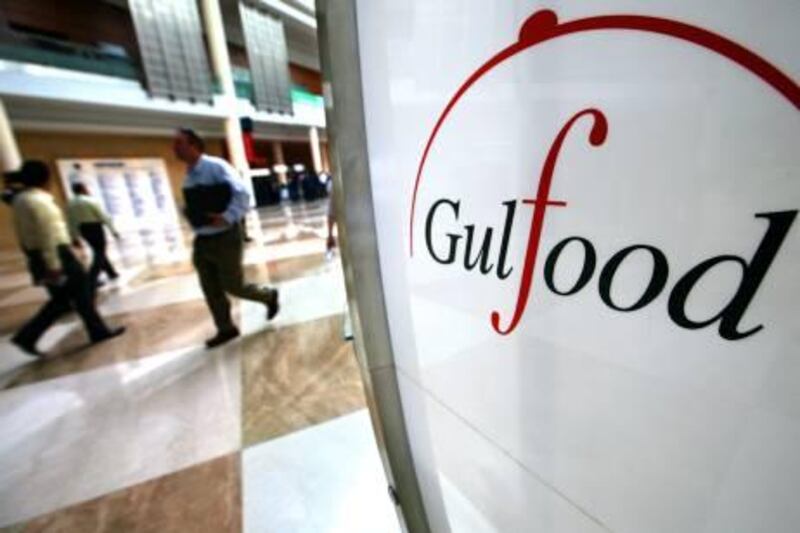Halal dim sum from Singapore and South African ostrich meat are just two of the numerous speciality foods that will be on show this week in the UAE, as international companies descend on Dubai in search of lucrative contracts.
Hundreds of million of dollars of deals are expected to be signed at the four-day Gulfood exhibition, which starts today, as companies count on the event to help grow exports.
As concerns persist about the euro-zone economy, and with production costs running high, countries are more than ever striving to boost their food exports to the highly import-dependent UAEas well as to the rest of the Middle East.
"I think with the issues in the euro zone, we're worried as to how the whole crisis will be resolved," says Yacoob Abba Omar, South Africa's ambassador to the UAE.
"This market really becomes very important for us, and that's why we're so heavily invested in making sure we promote in the UAE in particular. The market will keep growing for a long while to come."
Food and agricultural exports to the UAE from South Africa, including fruit, sugar cane and ostrich meat, increased by about 3.5 per cent last year compared with 2010, Mr Omar says.
Scotland is also turning to this region for food trade growth amid economic uncertainty in the euro zone, its biggest customer.
Food and drink exports to the UAE from Scotland increased by 55 per cent to US$80 million (Dh293.8m) in the first two quarters of last year compared with the same period a year earlier, according to figures from the Scottish government. Aside from the EU, the Middle East has become the largest market for smoked salmon from Scotland. Almost 800 tonnes of salmon from Scotland came into the region in the first half of last year.
Scottish companies are expecting to do more business than ever at Gulfood this week.
"This year will clearly be our best year - I'm very confident of that," says Ewen Cameron, the international senior manager for food and drink at Scottish Development International.
"Traditionally, [for] the Scottish food and drink industry, the euro zone would be our strongest export market, and it still is.
"I think we'll expect potentially some decline, although we haven't seen that appearing in any of the export data yet. But because of the challenges in the euro zone, I think that will affect exports."
Much of the business is being driven by supplying the growing number of five-star hotels in the UAE, Mr Cameron explains. "I would say within the UAE the biggest growth opportunities are within the salmon and the seafood sectors."
Demand for the exhibition has been strong this year. Lester Lu, International Enterprise Singapore's regional director, said the promotions agency wanted to expand the Singapore pavilion, which features more than 40 food and beverage companies, but there was no more space available.
"I think the Middle East holds more promise [for food exports]," said Mr Lu. Forty-five per cent of the food that comes to the Middle East from Singapore goes to the UAE, he said.
Production costs for exporters have also risen in many cases, which makes winning deals all the more important, Mr Lu said. "Some exporters have said that their cost of goods in terms of producing their products have gone up."
Exhibitors from Singapore generated almost $14m in food and beverage sales to the GCC as a result of taking part in Gulfood last year, according to International Enterprise Singapore.
Cooking sauces and vegetable oils are among the main goods Singapore sells in the region.
Singapore food exports to the Gulf reached $286m last year, an annual compounded growth rate of 16 per cent since 2006.
"Everything that goes on your plate comes from some company we have got at the show," said Mark Napier, the director of the Dubai World Trade Centre and organiser of Gulfood.
"Everything from the food, the plate it's served on, the food processors right through the chain to where it is grown."
Mr Napier said France has brought the biggest trade pavilion to the UAE. Germany has the biggest delegation, occupying 3,000 square metres, with Turkey close behind at 2,000 sq metres.
The exhibition will host 3,800 companies and 110 pavilions representing countries from around the world.
"Obviously there are a lot of new products being launched into the country. Producers are now making things faster, quicker and more effectively," said Mr Napier.
Egypt will exhibit the same number of companies as last year, but Mr Napier said their outlook on doing business has changedsince the revolution in the country this time last year.
"The only difference is expectations are higher," Mr Napier said. "They are very excited about the business opportunity and keen to acknowledge that there's continued trade there."
twitter: Follow our breaking business news and retweet to your followers. Follow us





